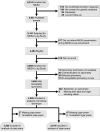The association of pipe and cigar use with cotinine levels, lung function, and airflow obstruction: a cross-sectional study
- PMID: 20157134
- PMCID: PMC2906916
- DOI: 10.7326/0003-4819-152-4-201002160-00004
The association of pipe and cigar use with cotinine levels, lung function, and airflow obstruction: a cross-sectional study
Abstract
Background: Cigarette smoking is the major cause of chronic obstructive pulmonary disease, but studies on the contribution of other smoking techniques are sparse.
Objective: To determine whether pipe and cigar smoking was associated with elevated cotinine levels, decrements in lung function, and increased odds of airflow obstruction.
Design: Cross-sectional study.
Setting: Population-based sample from 6 U.S. communities.
Participants: Men and women aged 48 to 90 years without clinical cardiovascular disease at enrollment who were part of MESA (Multi-Ethnic Study of Atherosclerosis).
Measurements: The MESA Lung Study measured spirometry according to American Thoracic Society guidelines and urine cotinine levels by immunoassay on a subsample of MESA. Pipe-years and cigar-years were calculated as years from self-reported age of starting to age of quitting (or to current age in current users) multiplied by pipe-bowls or cigars per day.
Results: Of 3528 participants, 9% reported pipe smoking (median, 15 pipe-years), 11% reported cigar smoking (median, 6 cigar-years), and 52% reported cigarette smoking (median, 18 pack-years). Self-reported current pipe and cigar smokers had elevated urine cotinine levels compared with never-smokers. Pipe-years were associated with decrements in FEV(1), and cigar-years were associated with decrements in the FEV(1)-FVC ratio. Participants who smoked pipes or cigars had increased odds of airflow obstruction whether they had also smoked cigarettes (odds ratio, 3.43 [95% CI, 1.75 to 6.71]; P < 0.001) or not (odds ratio, 2.31 [CI, 1.04 to 5.11]; P = 0.039) compared with participants with no smoking history.
Limitation: Cross-sectional design.
Conclusion: Pipe and cigar smoking increased urine cotinine levels and was associated with decreased lung function and increased odds of airflow obstruction, even in participants who had never smoked cigarettes.
Primary funding source: National Heart, Lung, and Blood Institute, National Institutes of Health.
Figures


Comment in
-
Tobacco smoke by any other name is still as deadly.Ann Intern Med. 2010 Feb 16;152(4):259-60. doi: 10.7326/0003-4819-152-4-201002160-00011. Ann Intern Med. 2010. PMID: 20157140 No abstract available.
Summary for patients in
-
Summaries for patients: Pipe and cigar smoking and lung function.Ann Intern Med. 2010 Feb 16;152(4):I-28. doi: 10.7326/0003-4819-152-4-201002160-00001. Ann Intern Med. 2010. PMID: 20157119 No abstract available.
References
-
- Trosclair A, Caraballo R, Malarcher A, Husten C, Pechacek T. Cigarette Smoking Among Adults---United States, 2003. MMWR. 2005;54(20):509–513. - PubMed
-
- Flint M. Tobacco Use, Access, and Exposure in Media Among Middle School and High School Students. CDC MMWR. 2005;54(12) - PubMed
-
- Cigarette Smoking Among Adults -- United States MMWR: Morbidity & Mortality Weekly Report. 2007;2008;57(45):1221–1226. - PubMed
-
- Baker F, Ainsworth SR, Dye JT, Crammer C, Thun MJ, Hoffmann D, et al. Health risks associated with cigar smoking. JAMA. 2000;284(6):735–40. - PubMed
-
- Substance Abuse and Mental Health Services Administration . Results from the 2006 National Survey on Drug Use and Health: National Findings. Vol. NSDUH Series H-32, DHHS Publication No. SMA 07-4293. Office of Applied Studies; Rockville, MD: 2007.
Publication types
MeSH terms
Substances
Grants and funding
LinkOut - more resources
Full Text Sources
Medical
Molecular Biology Databases
